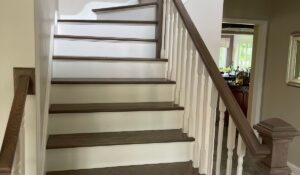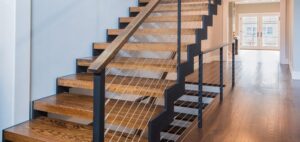When it comes to home design and renovation, wood stairs often stand out as a classic choice. Their timeless appeal and versatility make them a popular option for many homeowners. Here, we’ll explore the top ten benefits of choosing wood stairs for your home, delving into the practical and aesthetic advantages they offer.
1. Timeless Elegance
Wood stairs bring an unmatched elegance and warmth to any home. Their natural beauty and variety of finishes allow them to complement almost any interior design style, from traditional to contemporary. Unlike some modern materials, wood ages gracefully, developing a rich patina over time. This enduring aesthetic appeal means wood stairs can seamlessly blend with changing trends and tastes, maintaining their charm for years to come.

2. Versatility in Design
One of the most compelling benefits of wood stairs is their design versatility. Wood can be easily customized to suit different styles, from sleek, minimalist staircases to ornate, intricate designs. You can choose from various types of wood, such as oak, maple, cherry, or walnut, each offering its unique grain patterns and colors. Additionally, wood stairs can be stained or painted in virtually any hue, allowing for a high degree of personalization and integration into your home’s décor.
3. Durability and Longevity
High-quality wood stairs are incredibly durable and can last for many decades with proper care. Wood is a sturdy material that can withstand heavy foot traffic and regular use. Hardwoods like oak and maple are particularly resilient, making them ideal for stairs that will see frequent use. With routine maintenance, such as refinishing and sealing, wood stairs can remain in excellent condition for a lifetime, providing both aesthetic and functional longevity.
4. Easy Maintenance
Maintaining wood stairs is relatively straightforward compared to other materials. Regular sweeping or vacuuming and periodic cleaning with a wood-friendly cleaner are typically all that’s required to keep them looking their best. Additionally, any minor scratches or dents can often be easily repaired through sanding and refinishing. This ease of upkeep ensures that wood stairs can continue to enhance your home without requiring excessive effort to maintain their appearance.
5. Enhanced Value
Wood stairs can significantly boost the resale value of a home. Potential buyers often view wood staircases as a premium feature, adding an element of luxury and quality to the property. The aesthetic appeal, combined with the durability and low maintenance of wood, makes it a desirable feature that can set your home apart from others on the market. Investing in wood stairs is not only a choice that enhances your living space but also one that can yield financial benefits in the long term.

6. Eco-Friendliness
For environmentally conscious homeowners, wood stairs offer a more sustainable option compared to many synthetic materials. Wood is a renewable resource, and when sourced from responsibly managed forests, it has a lower environmental impact. Many manufacturers also use eco-friendly finishes and adhesives, further reducing the carbon footprint of wood stairs. By choosing wood, you contribute to environmental conservation while enjoying the beauty and functionality of a natural material
7. Comfort and Warmth
Wood stairs provide a unique sense of comfort and warmth that other materials often lack. The natural properties of wood create a softer and more pleasant walking surface, which can be particularly beneficial in homes where comfort is a priority. Unlike cold, hard materials such as metal or stone, wood offers a warmer feel underfoot, making it a more inviting choice for staircases that see daily use.
8. Acoustic Benefits
Wood stairs have advantageous acoustic properties. They tend to absorb sound more effectively than harder materials, reducing noise levels and echo in the home. This can be particularly beneficial in multi-story homes or apartments where noise transfer between floors might be a concern. The natural density and texture of wood help to create a quieter, more comfortable living environment, enhancing the overall acoustic quality of your home.
9. Customization Opportunities
The inherent flexibility of wood allows for extensive customization options. Homeowners can choose from a variety of wood species, grain patterns, and finishes to create a staircase that perfectly aligns with their vision. Additionally, wood staircases can be designed with unique features such as decorative balusters, custom handrails, and intricate riser details. This level of customization ensures that your stairs not only meet functional needs but also reflect your personal style and preferences.
10. Increased Safety
Wood stairs can offer improved safety features when compared to other materials. For example, wooden treads can be treated with anti-slip coatings to enhance traction, reducing the risk of slips and falls. Additionally, wood is a naturally non-conductive material, meaning it won’t become dangerously slippery when wet, unlike some types of metal or tile. By investing in high-quality wood stairs and incorporating safety features, you can create a secure environment for all occupants of your home.
Conclusion
Wood stairs are more than just a functional element in a home; they represent a combination of beauty, durability, and versatility. From their timeless elegance and design flexibility to their ease of maintenance and eco-friendly attributes, wood stairs offer a wide range of benefits that make them a worthwhile investment. Whether you’re looking to enhance the aesthetic appeal of your home, improve its resale value, or simply enjoy the comfort and warmth of natural materials, wood stairs provide a compelling choice that continues to stand the test of time. https://top7secrets.com/shower-standing-…and-independence
